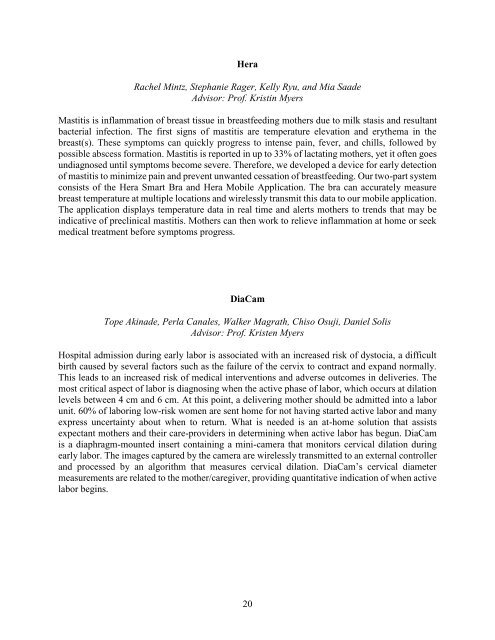Senior Design Expo 2019
The Senior Design Expo, held annually in May at Columbia University, is an opportunity for Columbia Engineering students to showcase what they have learned in their foundational math and science courses together with their engineering courses in innovative, creative, and purposeful designs and prototypes. Each year the Expo showcases more than 60 projects across all nine departments. Projects have included cutting-edge robotics, the New York City subway system, language technology, proposals for bridges to span the Hudson river, and much more.
The Senior Design Expo, held annually in May at Columbia University, is an opportunity for Columbia Engineering students to showcase what they have learned in their foundational math and science courses together with their engineering courses in innovative, creative, and purposeful designs and prototypes. Each year the Expo showcases more than 60 projects across all nine departments. Projects have included cutting-edge robotics, the New York City subway system, language technology, proposals for bridges to span the Hudson river, and much more.
You also want an ePaper? Increase the reach of your titles
YUMPU automatically turns print PDFs into web optimized ePapers that Google loves.
Hera<br />
Rachel Mintz, Stephanie Rager, Kelly Ryu, and Mia Saade<br />
Advisor: Prof. Kristin Myers<br />
Mastitis is inflammation of breast tissue in breastfeeding mothers due to milk stasis and resultant<br />
bacterial infection. The first signs of mastitis are temperature elevation and erythema in the<br />
breast(s). These symptoms can quickly progress to intense pain, fever, and chills, followed by<br />
possible abscess formation. Mastitis is reported in up to 33% of lactating mothers, yet it often goes<br />
undiagnosed until symptoms become severe. Therefore, we developed a device for early detection<br />
of mastitis to minimize pain and prevent unwanted cessation of breastfeeding. Our two-part system<br />
consists of the Hera Smart Bra and Hera Mobile Application. The bra can accurately measure<br />
breast temperature at multiple locations and wirelessly transmit this data to our mobile application.<br />
The application displays temperature data in real time and alerts mothers to trends that may be<br />
indicative of preclinical mastitis. Mothers can then work to relieve inflammation at home or seek<br />
medical treatment before symptoms progress.<br />
DiaCam<br />
Tope Akinade, Perla Canales, Walker Magrath, Chiso Osuji, Daniel Solis<br />
Advisor: Prof. Kristen Myers<br />
Hospital admission during early labor is associated with an increased risk of dystocia, a difficult<br />
birth caused by several factors such as the failure of the cervix to contract and expand normally.<br />
This leads to an increased risk of medical interventions and adverse outcomes in deliveries. The<br />
most critical aspect of labor is diagnosing when the active phase of labor, which occurs at dilation<br />
levels between 4 cm and 6 cm. At this point, a delivering mother should be admitted into a labor<br />
unit. 60% of laboring low-risk women are sent home for not having started active labor and many<br />
express uncertainty about when to return. What is needed is an at-home solution that assists<br />
expectant mothers and their care-providers in determining when active labor has begun. DiaCam<br />
is a diaphragm-mounted insert containing a mini-camera that monitors cervical dilation during<br />
early labor. The images captured by the camera are wirelessly transmitted to an external controller<br />
and processed by an algorithm that measures cervical dilation. DiaCam’s cervical diameter<br />
measurements are related to the mother/caregiver, providing quantitative indication of when active<br />
labor begins.<br />
20








